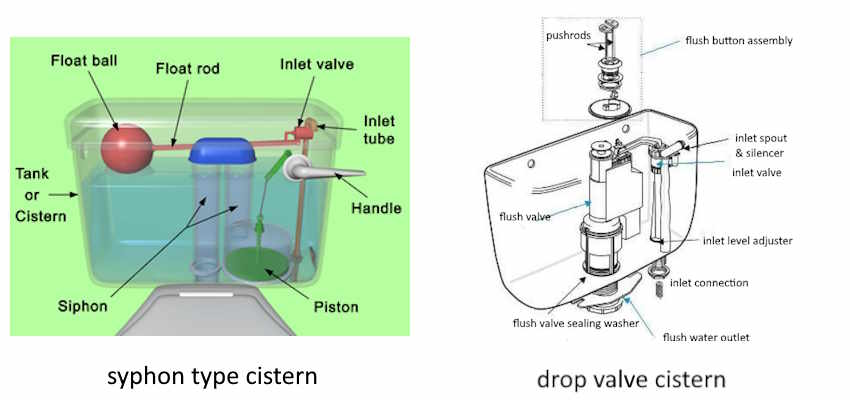The cistern is simply a tank containing water for flushing your toilet.
The workings are also very straight forward, and the principals are the same for all designs of cistern. There is a filler valve which controls the supply of water into the cistern, and a flush valve which lets the water out when the flush lever or button is operated.

Here's how the two most common types work
In the syphon cistern (above left) water enters via the inlet tube from a 15mm supply pipe attached below the cistern. In some cases the supply can be behind or beside the cistern body but this drawing shows a bottom entry type. The inlet valve at the top allows water to flow into the cistern and is controlled by the float ball and rod. As the water level rises the float also moves up, as the name suggests it floats. When the float ball is high enough the rod shuts the valve and stops the water flow. The float ball can be moved on the end of the rod by a screw fitting, thus adjusting the fill level. This assembly is often called a ball cock.
Pressing down on the lever lifts the piston which pushes water up into the syphon. The water drops down the left syphon tube ant out through the flush pipe into the pan. Water continues to syphon out until the tank is empty. This type of cistern typically uses 7.5L or 8L per flush, so it's quite heavy on water consumption.
The modern drop valve cistern (above right) has a similar inlet tube with a 15mm connection at the feed end and an inlet valve at the top. Water enters through the spout which often has a small rubber tube end designed to reduce the splashing and noise made by the incoming water. The valve is controlled by a float, similar but much smaller than the float ball, and is shut off when the float reaches a pre-set height. The level can be easily adjusted by a turning knob below the inlet valve.
Flushing is achieved by pressing the flush button on top of the cistern lid. There are often two flush buttons to offer a full or half flush. Pressing one button causes one of the pushrods to press down and open one of the flush valves, allowing water down through the pipe into the toilet pan. The two flush valves inside the assemble are set at different heights, so one will only empty half the tank when opened, but the other will allow the tank to empty completely. A full flush here normally uses around 6L and the half flush around 3L or 3.5L, so this is a much more water efficient system.
Both types have an overflow tube (not illustrated) which can be set to different levels, and this will drain off any excess water if the inlet valve happens to stick on, preventing a flood in the bathroom.



